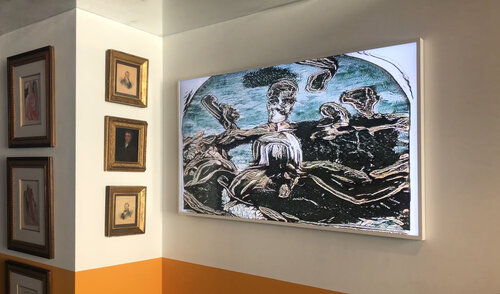In recent years, we’ve seen some amazing advancements in the world of digital art. Improved digital canvas quality, size, and format, and the protection for artists creating digital art through NFTs. As impressive as the Samsung Frame TV is, it’s still in a format that most people see as a TV. The 16:9 format has been the standard for nearly every TV since the early 2000s. Anyone who sees that format, regardless of what it is, thinks it’s a TV, so having artwork in the same format distracts from the artwork slightly.

Only in very recent years have a few manufacturers decided to create digital canvases in traditional artwork sizes, as well as allowing for complete custom layouts. This gives consumers access to more artwork options and artists more creativity to create artwork that isn’t fixed to the 16:9 format. LED and OLED displays have allowed for these new custom sizes and formats, as well as being extremely thin. The options for digital canvases go further than just flat-panel tech, projector mapping, and video wall. Technology has provided options for extremely large-format art and immersive art installations.
Where Do Integrators Come In?
Having knowledge about light output, viewing angles, mounting options, reflection obstacles, and proper installation, as well as video calibration, should all be considered, which is why having an integrator involved will be extremely important. CEDIA recommends every projector and display be properly calibrated to preserve artistic intent for replaying movies and digital art. The consumer, along with artists and interior designers, will appreciate that a display is producing the correct colors at the right light levels.
Analog art can be copied and forged, but for valuable pieces it has become extremely difficult. Digital art, on the other hand, was easily copied at first since there are ways around leaving any digital footprint after copying or manipulating. Software developer Meni Rosenfield wrote a paper in 2012 that was the beginning of the NFT story. The paper described methods to manage real-world assets and prove ownership. This process, similar to Bitcoins, adds a toke that makes each item unique. NFT, by the way, stands for Non-Fungible Token. It can represent ownership in almost anything, from digital art to virtual real estate.
Also by Ian Bryant: Defining Wellness for Custom Installers
In 2021, the market hit mainstream. NFTs allow artists who create digital art or analog art converted to digital to be authentic and transferable to different owners just like analog art is bought and sold. Someone can purchase a particular image for a real dollar amount and say they own the original. It can be copied a million times, but there’s only one original, and someone owns it through the use of an NFT.
That’s what makes this technology attractive: it’s authentic and unique and no one else can have the original. Creating art can be difficult and expensive. Duplicating that art by making prints, matting the prints, framing them, and distributing them is not cheap. Allowing an artist to sell copies digitally, whether it started that way or not, is easier and opens new possibilities for reaching art enthusiasts and collectors. It also allows their art to be displayed as intended.
Integrators and the Future of Digital Art
The craze of creating images just to create an NFT will likely slow down, but the artists using this technology to expand their reach and grow creatively will increase. This is where technology integrators come in. High-quality digital canvases need a technology specialist to specify, design, and install the product accurately and to the client’s expectations. This is a great chance for an integrator to work with the designer on a project, or with the homeowner in ways we haven’t been able to in the past.
Artwork is personal and can change the design and feel of a room. Outside of the media/entertainment space, this is a new area for the integrator. As the industry starts to move more into thoughtful design and lifestyle, digital art is a perfect ways for the integrator to provide experiences for their customers through amazing art installations. There are museums and galleries displaying digital art, corporate installations, and public spaces that often require large, complex, and immersive displays integrators have experience installing. This is another avenue for residential integrators to grow into the light commercial space.
Related: Blackdove Curates the Digital Art Experience for Custom Integrators
As the integrator channel diversifies into new areas of the home, digital art can be a breath of fresh air, showing the world we are more than just the “AV person.” The shift in services and relationships is how an integrator will become known as someone who enhances and improves lifestyles at home. Digital art creates a great gateway because the consumer will be able to see the necessity of a well-trained integrator when they’re better able to interpret, appreciate, and enjoy the art. Technology and the integrator will both be important in the future of art.
If you’re interested in learning more, CEDIA offers ISF training online and in-person for those interested in calibration training. We’ve also recently released the Integrator of 2027 White Paper, which covers these topics as well.
Read more about digital art on The Cinema Connoisseur: Art Connoisseurship in a Digital World






